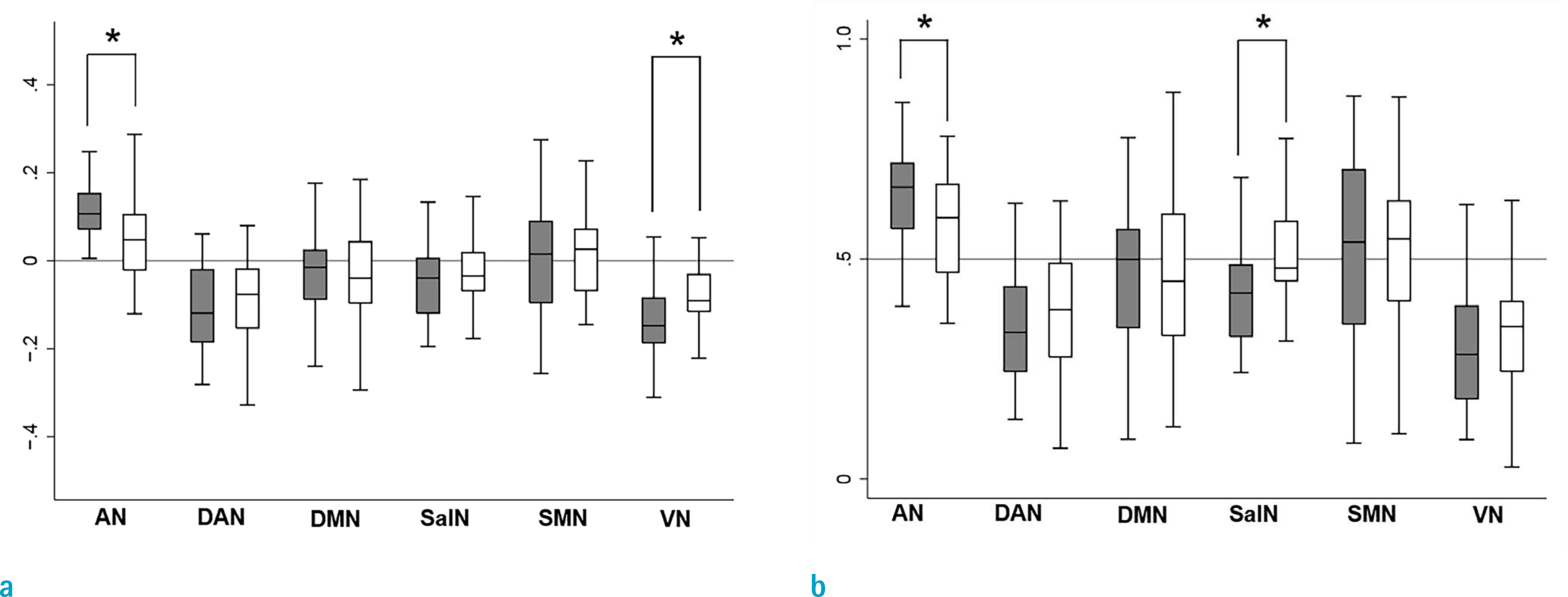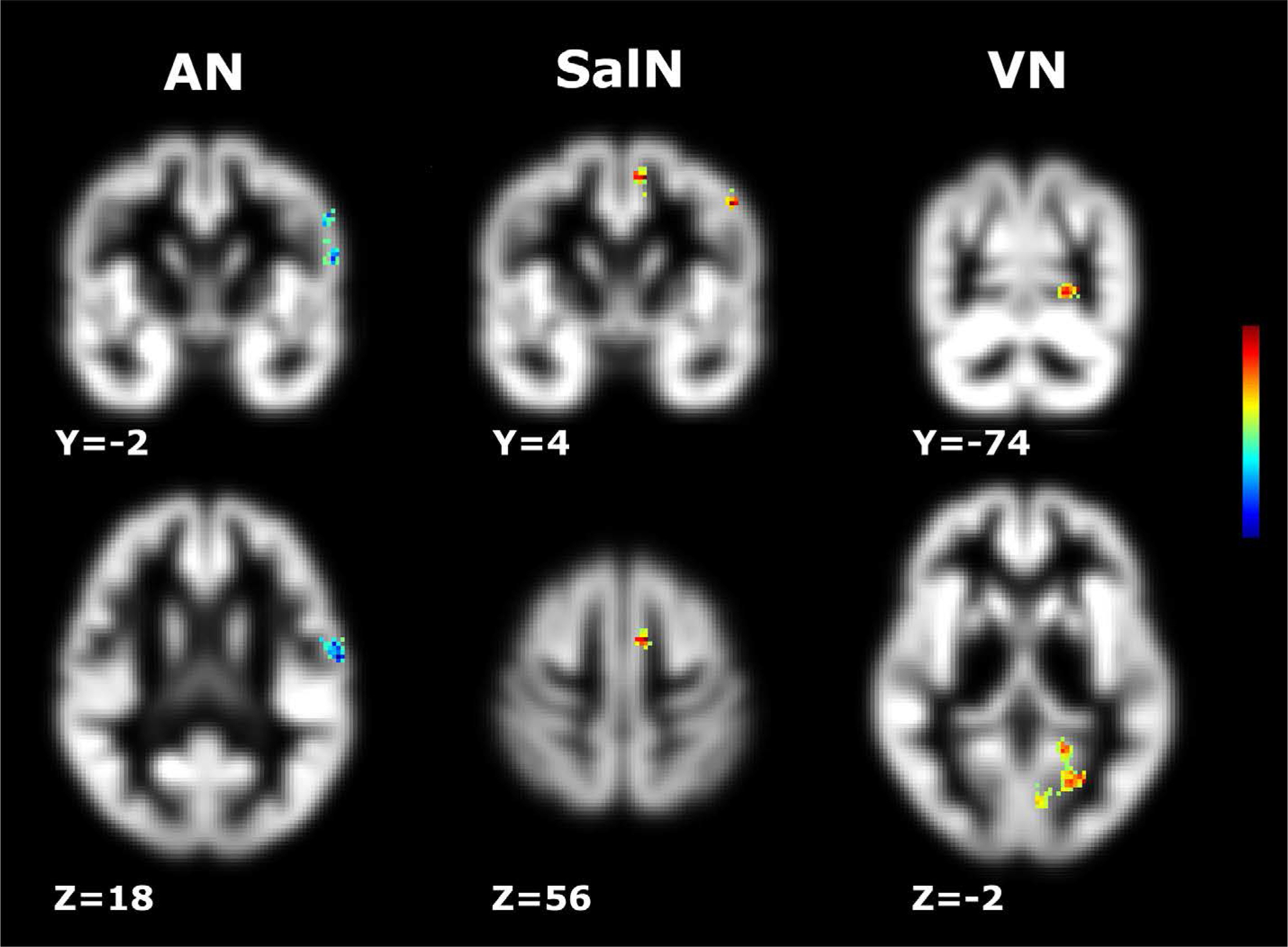Investig Magn Reson Imaging.
2019 Mar;23(1):55-64. 10.13104/imri.2019.23.1.55.
Changes in the Laterality of Functional Connectivity Associated with Tinnitus: Resting-State fMRI Study
- Affiliations
-
- 1Department of Radiology, Kyung Hee University Hospital at Gangdong, School of Medicine, Kyung Hee University, Seoul, Korea. md.cwryu@gmail.com
- 2Department of Otorhinolaryngology, Kyung Hee University Hospital at Gangdong, School of Medicine, Kyung Hee University, Seoul, Korea.
- KMID: 2442234
- DOI: http://doi.org/10.13104/imri.2019.23.1.55
Abstract
- PURPOSE
One of the suggested potential mechanisms of tinnitus is an alteration in perception in the neural auditory pathway. The aim of this study was to investigate the difference in laterality in functional connectivity between tinnitus patients and healthy controls using resting state functional MRI (rs-fMRI).
MATERIALS AND METHODS
Thirty-eight chronic tinnitus subjects and 45 age-matched healthy controls were enrolled in this study. Connectivity was investigated using independent component analysis, and the laterality index map was calculated based on auditory (AN) and dorsal attention (DAN), default mode (DMN), sensorimotor, salience (SalN), and visual networks (VNs). The laterality index (LI) of tinnitus subjects was compared with that of normal controls using region-of-interest (ROI) and voxel-based methods and a two-sample unpaired t-test. Pearson correlation was conducted to assess the associations between the LI in each network and clinical variables.
RESULTS
The AN and VN showed significant differences in LI between the two groups in ROI analysis (P < 0.05), and the tinnitus group had clusters with significantly decreased laterality of AN, SalN, and VN in voxel-based comparisons. The AN was positively correlated with tinnitus distress (tinnitus handicap inventory), and the SalN was negatively correlated with symptom duration (P < 0.05).
CONCLUSION
The results of this study suggest that various functional networks related to psychological distress can be modified by tinnitus, and that this interrelation can present differently on the right and left sides, according to the dominance of the network.
Figure
Reference
-
References
1. Vigneau M, Beaucousin V, Herve PY, et al. What is right-hemisphere contribution to phonological, lexico-semantic, and sentence processing? Insights from a metaanalysis. Neuroimage. 2011; 54:577–593.2. Thiebaut de Schotten M, Dell'Acqua F, Forkel SJ, et al. A lateralized brain network for visuospatial attention. Nat Neurosci. 2011; 14:1245–1246.
Article3. Su L, An J, Ma Q, Qiu S, Hu D. Influence of resting-state network on lateralization of functional connectivity in mesial temporal lobe epilepsy. AJNR Am J Neuroradiol. 2015; 36:1479–1487.
Article4. Zhan J, Gao L, Zhou F, et al. Decreased regional homogeneity in patients with acute mild traumatic brain injury: a resting-state fMRI study. J Nerv Ment Dis. 2015; 203:786–791.5. Saleh S, Bagce H, Qiu Q, et al. Mechanisms of neural reorganization in chronic stroke subjects after virtual reality training. Conf Proc IEEE Eng Med Biol Soc. 2011; 2011:8118–8121.
Article6. Luo C, Zhang X, Cao X, et al. The lateralization of intrinsic networks in the aging brain implicates the effects of cognitive training. Front Aging Neurosci. 2016; 8:32.
Article7. Geven LI, de Kleine E, Willemsen AT, van Dijk P. Asymmetry in primary auditory cortex activity in tinnitus patients and controls. Neuroscience. 2014; 256:117–125.
Article8. Smits M, Kovacs S, de Ridder D, Peeters RR, van Hecke P, Sunaert S. Lateralization of functional magnetic resonance imaging (fMRI) activation in the auditory pathway of patients with lateralized tinnitus. Neuroradiology. 2007; 49:669–679.
Article9. Schecklmann M, Landgrebe M, Poeppl TB, et al. Neural correlates of tinnitus duration and distress: a positron emission tomography study. Hum Brain Mapp. 2013; 34:233–240.
Article10. Newman CW, Jacobson GP, Spitzer JB. Development of the tinnitus handicap inventory. Arch Otolaryngol Head Neck Surg. 1996; 122:143–148.
Article11. Watkins KE, Paus T, Lerch JP, et al. Structural asymmetries in the human brain: a voxel-based statistical analysis of 142 MRI scans. Cereb Cortex. 2001; 11:868–877.
Article12. Calhoun VD, Adali T, Pearlson GD, Pekar JJ. A method for making group inferences from functional MRI data using independent component analysis. Hum Brain Mapp. 2001; 14:140–151.
Article13. Himberg J, Hyvarinen A, Esposito F. Validating the independent components of neuroimaging time series via clustering and visualization. Neuroimage. 2004; 22:1214–1222.
Article14. Erhardt EB, Rachakonda S, Bedrick EJ, Allen EA, Adali T, Calhoun VD. Comparison of multi-subject ICA methods for analysis of fMRI data. Hum Brain Mapp. 2011; 32:2075–2095.
Article15. Smith SM, Fox PT, Miller KL, et al. Correspondence of the brain's functional architecture during activation and rest. Proc Natl Acad Sci U S A. 2009; 106:13040–13045.
Article16. Damoiseaux JS, Rombouts SA, Barkhof F, et al. Consistent resting-state networks across healthy subjects. Proc Natl Acad Sci U S A. 2006; 103:13848–13853.
Article17. Agcaoglu O, Miller R, Mayer AR, Hugdahl K, Calhoun VD. Lateralization of resting state networks and relationship to age and gender. Neuroimage. 2015; 104:310–325.
Article18. Tomasi D, Volkow ND. Laterality patterns of brain functional connectivity: gender effects. Cereb Cortex. 2012; 22:1455–1462.
Article19. Swanson N, Eichele T, Pearlson G, Kiehl K, Yu Q, Calhoun VD. Lateral differences in the default mode network in healthy controls and patients with schizophrenia. Hum Brain Mapp. 2011; 32:654–664.
Article20. Chen YC, Xia W, Feng Y, et al. Altered interhemispheric functional coordination in chronic tinnitus patients. Biomed Res Int. 2015; 2015:345647.
Article21. Burton H, Wineland A, Bhattacharya M, Nicklaus J, Garcia KS, Piccirillo JF. Altered networks in bothersome tinnitus: a functional connectivity study. BMC Neurosci. 2012; 13:3.
Article22. Maudoux A, Lefebvre P, Cabay JE, et al. Auditory resting-state network connectivity in tinnitus: a functional MRI study. PLoS One. 2012; 7:e36222.
Article23. Duquette P. Increasing our insular world view: interoception and psychopathology for psychotherapists. Front Neurosci. 2017; 11:135.
Article24. Sikora M, Heffernan J, Avery ET, Mickey BJ, Zubieta JK, Pecina M. Salience network functional connectivity predicts placebo effects in major depression. Biol Psychiatry Cogn Neurosci Neuroimaging. 2016; 1:68–76.
Article25. Barrett LF, Quigley KS, Hamilton P. An active inference theory of allostasis and interoception in depression. Philos Trans R Soc Lond B Biol Sci. 2016; 371.
Article26. Seeley WW, Menon V, Schatzberg AF, et al. Dissociable intrinsic connectivity networks for salience processing and executive control. J Neurosci. 2007; 27:2349–2356.
Article27. Michalka SW, Kong L, Rosen ML, Shinn-Cunningham BG, Somers DC. Short-term memory for space and time flexibly recruit complementary sensory-biased frontal lobe attention networks. Neuron. 2015; 87:882–892.
Article28. Zhang J, Chen YC, Feng X, et al. Impairments of thalamic resting-state functional connectivity in patients with chronic tinnitus. Eur J Radiol. 2015; 84:1277–1284.
Article29. Ueyama T, Donishi T, Ukai S, et al. Brain regions responsible for tinnitus distress and loudness: a resting-state FMRI study. PLoS One. 2013; 8:e67778.
Article30. Carpenter-Thompson JR, Schmidt SA, Husain FT. Neural plasticity of mild tinnitus: an fMRI investigation comparing those recently diagnosed with tinnitus to those that had tinnitus for a long period of time. Neural Plast. 2015; 2015:161478.
Article
- Full Text Links
- Actions
-
Cited
- CITED
-
- Close
- Share
- Similar articles
-
- Change in Functional Connectivity in Tinnitus and its Relation with Tinnitus Laterality
- Resting-State Electroencephalography (EEG) Functional Connectivity Analysis
- Three Large-Scale Functional Brain Networks from Resting-State Functional MRI in Subjects with Different Levels of Cognitive Impairment
- Clinical Personal Connectomics Using Hybrid PET/MRI
- Recent Advances on Resting State Functional Abnormalities of the Default Mode Network in Social Anxiety Disorder





